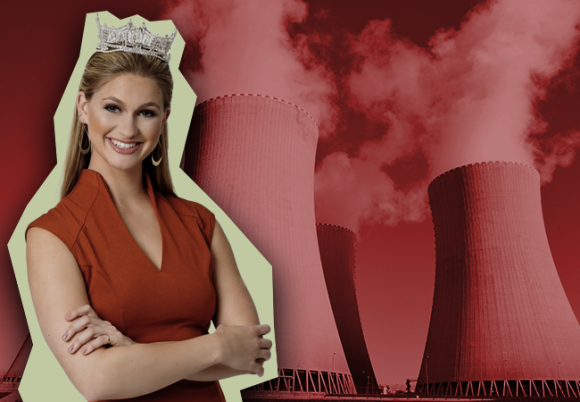Overwhelming evidence is proving the Coalition's nuclear plan to be a scam, writes Steve Bishop.
OPPOSITION LEADER Peter Dutton is scamming Australians with a nuclear power promise he knows he cannot deliver.
LNP research would have revealed the impossibility of providing nuclear power by the Coalition's target of the mid-2030s.
This means a Dutton government would continue the years of Coalition ineptitude in tackling climate change and failing to provide a workable energy policy.
Coalition Senator Matt Canavan has revealed it's nothing more than a “fix”.
Canavan said:
“Nuclear is not going to cut it. But we're latching on to it... because it fixes a political issue for us... But it ain't the cheapest form of power.”
In other words, it's a con. Or to use a good Aussie word: a rort.
It's why an internet search has found no trace of an authoritative nuclear body or expert endorsing the Coalition's nuclear timeframe.
It's simply a version of the old-time medicine show that peddled worthless cures to the gullible. The evidence demonstrates that the flimflammery of Mr Dutton's Miracle Nuclear Elixir cannot work.
Mr Dutton promised:
‘A Federal Coalition Government will initially develop two establishment projects using either small modular reactors or modern larger plants such as the AP1000 or APR1400. They will start producing electricity by 2035 (with small modular reactors) or 2037 (if modern larger plants are found to be the best option).’
The CSIRO found in its GenCost 2023‐24 report that the earliest deployment for large-scale nuclear rectors would not occur until after 2040.
In the U.S., which has a nuclear power industry, AP1000 units at Vogtle, Georgia took 15 years to build, more than twice the projected timeline.
In Finland, the 1600mw Olkiluoto 3 was completed in 2023 — 18 years after construction started.
Even in China, with fewer hurdles to jump and a massive nuclear industry, it took 14 years for the Sanmen1 nuclear power station to be completed with plans for two units approved in 2004 and the first 1200mw reactor starting commercial operation on September 2018.
So it would be impossible to switch on a large plant in Australia before 2040. Is it feasible for the Coalition to build small modular reactors (SMRs) by 2035 as projected?
The ANU Institute for Climate, Energy and Disaster Solutions suggests it would be more like 15 years before the first reactor could start producing.
It says:
In Western countries... recent construction times have far exceeded a decade.
Before any nuclear power plant can be built here, we would first need to establish a regulatory system. That could take up to five years.
The Institute for Energy Economics and Financial Analysis (IEEFA) has found:
‘SMRs would not be operating before the 2040s in Australia, too late to replace coal.’
It also revealed construction delays of 12 to 13 years had occurred in four of the few completed SMRs in Argentina, China and Russia.
Similarly, the Australian Academy of Technological Sciences and Engineering (ATSE) has found
‘...a mature market for the technology may emerge in the late 2040s.’
Professor Hugh Durrant-Whyte, a nuclear engineer, told a NSW inquiry in 2020 that it would be naïve to think a power plant could be built in less than two decades.
The UK, which already has nuclear power stations, claims it is running the world's fastest process to deliver an operational SMR by the mid-2030s. But it started this process in 2021 with a target date of the early 2030s and that has already blown out to the mid-2030s — some 16 years on from 2021.
This process aims to invest in demonstration SMRs in 2029. But a research paper filed on Social Science Research Network (SSRN) has found that if it then takes only two years to deploy resources ready for construction, only three years to build the plant and a further two years to demonstrate successful operation, any follow-on capacity would only come online well after 2040.
Even if a Coalition government was able to emulate this “fastest” process it would be after 2040 before an SMR is built. But a graph on page 7 of the plan released by Mr Dutton shows about 1,750mw of nuclear power being produced by 2036.
That would require six reactors having gone through the planning process, built, tested and commissioned — an impossibility based on the expert evidence.
In June, Mr Dutton said:
“I’m very happy for the Election to be a referendum on energy, on nuclear, on power prices...”
The overwhelming evidence means the Coalition scam should be rejected at the ballot box.
Steve Bishop is a journalist and author. You can read more from Steve at stevebishop.net.
 This work is licensed under a Creative Commons Attribution-NonCommercial-NoDerivs 3.0 Australia License
This work is licensed under a Creative Commons Attribution-NonCommercial-NoDerivs 3.0 Australia License
Support independent journalism Subscribe to IA.

Related Articles
- Nuclear advocates: Splitting atoms and spinning agendas
- Dutton's atomic power bill for a 'nuclear family' could be nearly $39K
- Transparency over nuclear reactors vital in making decisions
- Peter Dutton's 'nuclear policy': It's 'unclear' at best
- DIY nuclear: Bin night just got a lot harder














